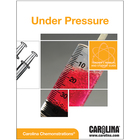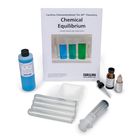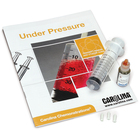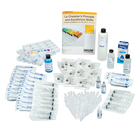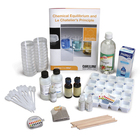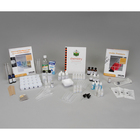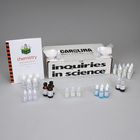Equilibrium Straw Activity
 Siobhan Julian
Siobhan Julian
Chemistry Teacher, Webster Schroeder High School
Webster, NY
November 2015
As chemistry teachers, we know that students can have misconceptions about the definition of equilibrium. With the word sounding so much like “equal,” many students naturally assume that the concentrations or amounts of reactants and products, rather than rates, must be equal at equilibrium. This short lab activity helps to dispel that notion while reinforcing the idea that it is the rate of exchange between the forward and reverse reaction that is the same.
Students will examine two systems. In the first, forward and reverse reactions are equally favored, modeled by students using straws of the same size to transfer water between the two containers. In the second, the forward reaction is more heavily favored than the reverse reaction, as modeled by students using straws of different sizes. In both cases, however, students will reach a point where there is no longer any volume change between the two containers, indicating that equilibrium has been reached.
After finishing the activity, students will practice their graphing and data interpretation skills.
Materials
- Graduated Cylinders, 50 mL (2 per lab group)
- Regular-Width Straws (1 per lab group)
- Large-Width Straws (2 per lab group; I recommend going to your local Dunkin’ Donuts and politely asking for a class set of their large orange straws)
- Tap Water
- Food Coloring (optional)
Procedure
Part I
- Place 50 mL of tap water into one graduated cylinder; leave the second cylinder empty. If desired, have your teacher place food coloring in the water and use the straw to mix.
- Place a large straw into each of the graduated cylinders.
- This step requires two people—one person for each straw. Ensuring that your straw is touching the bottom of the cylinder, cover the straw with your finger to trap the water. (This works best if you hold the straw with one hand and use a wetted finger on your other hand to seal the straw at the top.)
- Simultaneously transfer the contents of the straws between cylinders. Be careful not to let any water spill.
- Record the new volumes in the graduated cylinders (use Table 1 below).
- Return your empty straw to its original cylinder. Repeat steps 3–5 until the volumes stop changing for three successive transfers.
Part II
- Repeat Part I, this time using a larger-width straw for the cylinder that starts with 50 mL of water and a smaller-width straw for the cylinder that starts empty. Record your data in Table 2 below.
Table 1: Volume after x transfers (2 large-width straws)
| x | 0 | 1 | 2 | 3 | 4 | 5 | 6 | 7 | 8 | 9 | 10 | 11 | 12 | 13 | 14 | 15 | 16 | 17 | 18 | 19 | 20 |
| mL | 50 | ||||||||||||||||||||
| mL | 0 |
Table 2: Volume after x transfers (1 large-width straw, 1 smaller-width straw)
| x | 0 | 1 | 2 | 3 | 4 | 5 | 6 | 7 | 8 | 9 | 10 | 11 | 12 | 13 | 14 | 15 | 16 | 17 | 18 | 19 | 20 |
| mL | 50 | ||||||||||||||||||||
| mL | 0 |
Analysis
Have your students plot a graph for each table. The number of transfers should be shown on the x-axis, and volume in mL should be shown on the y-axis. Students should graph both graduated cylinders on the same graph, thereby having one curve that starts at 50 mL and a second that starts at 0 mL. Students should notice that for both graphs, the curves will eventually level off, indicating that equilibrium has been reached.
Follow up
Have your students explain how this activity models equilibrium. In particular, have them note the differences between Part I and Part II, and draw their attention to the purpose of the two straws. Hopefully, students should understand at the end of this activity that even though the amount of “product” and “reactant” might be different at equilibrium, as long as the rate of transfer is the same, equilibrium has been reached.
Extension activities
Explore more equilibrium activities with Carolina kits:
- Carolina ChemKits®: Chemical Equilibrium and Le Chatelier's Principle Kit (item #840709)
- Carolina Chemonstrations®: Under Pressure Kit (item #840364)
- Carolina Chemonstrations® for AP® Chemistry: Big Idea 6--Equilibrium (item #840350)
- Inquiries in Science®: Attaining Equilibrium Kit (item #251213)
- Carolina Investigations® for AP® Chemistry: Le Chatelier's Principle and Equilibrium Shifts (item #840594)
(Activity borrowed from Paul Groves, South Pasadena High School)


